Render#
The Render tab in Properties Editor exposes options related to game screen rendering.
Some of the options showed here may behave differently according to the conditions, as there are two separate game “players” for previewing the game during development. Note that while UPBGE is running in either player, the computer’s mouse and keyboard are captured by the game and by default, the mouse cursor is not visible (this can be changed in the Display panel of this tab). To exit the game, press the Esc key.
Note
Make sure that the render engine is set to UPBGE when attempting to set these controls, otherwise this description will not apply to what you see!
In Render tab, there are several panels available, as shown. Each one can be expanded or contracted using the usual triangle button. The features in each panel will be described in details below.
Embedded Player#
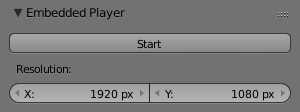
Embedded Player panel.#
This panel provides information for the Embedded Player which allows games to be run inside the Blender 3D View. The Embedded Player renders onto the 3D View editor in the Blender GUI using the current perspective and zoom level of the 3D View.
Note that the Resolution settings are independent of the size of the viewport preview pane. In fact, the Resolution controls seem to have no effect at all. The resolution and aspect ratio of the embedded preview are always fixed to the 3D View editor, which behaves much like the Extend framing mode for the Standalone Player.
- Start
Starts UPBGE inside the current Blender 3D View. Shortcut P while mouse hovers the desired 3D View.
- Resolution X/Y
Sets the internal X/Y rendering resolution.
Standalone Player#
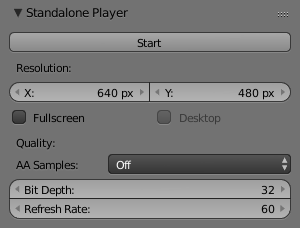
Standalone Player panel.#
This panel provides information for the Standalone Player which allows games to be run without Blender. See Standalone Player for further details.
The Standalone Player renders the scene from the perspective of the active scene camera and either creates a new desktop window or switches into fullscreen rendering mode.
The semantics of the Standalone Player’s Resolution controls differ for Windowed and Fullscreen modes. In Windowed mode (Fullscreen checkbox unchecked), the Resolution controls set the initial dimensions of the desktop window. The user may resize the window at any time, causing the rendering resolution to change accordingly. In Fullscreen mode (Fullscreen checkbox checked), the Resolution controls set the internal rendering resolution. The actual display resolution will be a best fit depending on the user’s hardware. In either mode, the aspect ratio/cropping/scaling are determined by the Framing selection under the Display panel.
Regarding Fullscreen mode, it is important to remember that the Resolution settings in Fullscreen mode are only hints to the operating system. Each display and monitor combination will have a different set of resolutions that they are capable of displaying; so there can be little confidence that all end-users will actually get the resolution you suggest; unless you choose one of the most standard resolutions (e.g. 800x600 or 1024x768). If you insist on using higher resolutions, then you may want to state clearly in your documentation that only certain resolutions are supported. In most other cases, the user’s machine may select a resolution that is close to the one suggested; but the results can be unpredictable, especially in Letterbox framing mode.
Note that the Desktop checkbox has no effect in Windowed mode.
- Start
Launches the current blend file with the Standalone Player.
Resolution
- X
Sets the X window size or fullscreen display resolution.
- Y
Sets the Y window size or fullscreen display resolution.
Fullscreen
- Off
Opens standalone game as a new window.
- On
Opens standalone game in fullscreen.
Desktop
- Off
Attempts to obey the Resolution specified above when in Fullscreen mode.
- On
Keeps the current desktop resolution when in Fullscreen mode.
Quality
- AA Samples
The number of AA samples to use for MSAA.
- Bit Depth
Number of bits used to represent color of each pixel in fullscreen display.
- Refresh Rate
Number of frames per second of fullscreen display.
Stereo#
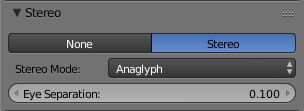
Stereo panel.#
Toggle if use an stereo mode and, if use, select a stereo mode that will be used to capture stereo images of the game (and also, by implication, that stereo displays will use to render images in the Standalone Player).
- None
Render single images with no stereo.
- Stereo
Render dual images for stereo viewing using appropriate equipment. See Stereo Camera for full details of available options.
Shading#

Shading panel.#
Specifies each singe visual components that will be rendered in the game.
- Lights
Toggles lights rendering.
- Shaders
Toggles GLSL shaders.
- Shadows
Toggles realtime shadows from lamps.
- Environment Lighting
Toggles environment lighting from World tab.
- Ramps
Toggles material ramps.
- Nodes
Toggles material nodes.
- Extra Textures
Toggles extra textures, like normal or specular maps.
System#
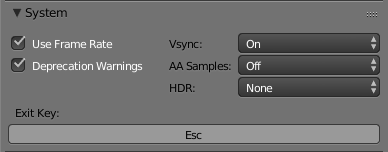
System panel in the Render tab.#
The System panel at the Render tab lets the game developer specify options about the system performance regarding to frame discard and restrictions about frame rendering, the key to stop UPBGE, etc.
- Use Frame Rate
Respect the frame rate rather than rendering as many frames as possible. When unchecked, this will inform Blender to run freely without frame rate restrictions. The frame rate is specified at the Display panel, also in the Render tab. For more information about frame rates, see Display panel.
- Deprecation Warnings
Every time when the game developer uses a deprecated functionality (which in some cases are outdated or crippled OpenGL Graphic cards functions), the system will emit warnings about the deprecated function on the console.
- Vsync
Change Vsync settings.
- AA Samples
Set how many samples use in anti-aliasing.
- HDR
The precision of the screen display (between 8, 16 and 32 bits).
- Exit Key
This button specifies which key-press will exit the game.
Animations#

Animations panel in the Render tab.#
Specifies animations settings of game, like frame rate.
- Animation Frame Rate
This number button/slider specify the maximum frame rate at which the game will run. Minimum is 1, maximum is 120.
- Restrict Animation Updates
Restrict number of animation updates to the animation FPS. This is better for performance, but can cause issues with smooth playback. When checked, this will force UPBGE to discard frames (even at the middle of redrawing, sometimes causing tearing artifacts) if the rate of frames rendered by the GPU is greater than the specified on Display panel.
Display#
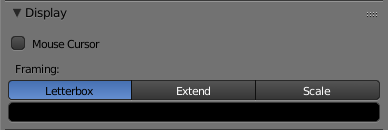
Display panel at the Render tab.#
The Display panel in the Render tab lets the game developer specify whether the mouse cursor is shown during the game execution, and options to specify the framing style of the game to fit the window with the specified resolution.
- Mouse Cursor
Whether to show or not the mouse cursor when the game is running.
- Framing
Selects how the scene is to be fitted onto the display window or screen. There are three types of framing available:
Letterbox
- In Windowed mode:
Maintains a 4:3 aspect ratio by scaling to fit the current window dimensions without cropping, covering any portions of the display that lie outside of the aspect ratio with color bars.
- In Fullscreen mode:
The behavior of this combination seems to be heavily dependent on the user’s hardware. The result can be quite unpredictable, especially when the resolution and aspect ratio differ too much from the machine’s capabilities. For this reason, Extend mode should be preferred for Fullscreen applications.
- Extend
This mode behaves much like Letterbox mode, maintaining a 4:3 aspect ratio by scaling whenever possible; except that the camera frustum is expanded or contracted wherever necessary to fill any portions of the display that lie outside of the aspect ratio, instead of covering those portions of the scene with color bars, as with Letterbox mode, or distorting then scene, as with Scale mode.
- Scale
In this mode, no attempt is made to maintain a particular aspect ratio. The scene and objects within will be stretched or squashed to fit the display exactly.
- Color Bar
This will let the game developer choose the bar colors when using the Letterbox Framing mode.
Debug#

Debug panel at the Render tab.#
The Debug panel at the Render tab toggles various specific debug helpers on UPBGE, from frame rate being showed on the screen to detailed physics visualization of specific elements, like armatures and camera frustum.
- Framerate and Profile
When checked, this will show values for each of the calculations Blender is doing while the game is running on the top left of the screen.
- Render Queries
Shows render queries information while the game runs.
- Properties
When checked, the values of any properties which are selected to be debugged in the objects are shown on the top left side of the screen.
- Physics Visualization
Shows a visualization of physics bounds and interactions (like hulls and collision shapes), and their interaction.
The following remaining options are dropdown menus which allows the following options: - Disable: Disables the debug of the current option. - Allow: Allow debugging from individual settings of the current option. - Force: Allow debugging of the current option.
- Bounding Box
Shows bounding volume boxes of objects while the game is running.
- Armatures
Shows armatures while the game is running.
- Camera Frustum
Shows camera limits visualization according to the current viewport dimensions while the game is running.
- Shadow Frustum
Shows lamp’s shadows bounds while the game is running.
Bake#
The Bake panel in the Render tab is very similar to its Blender Render counterpart and serves much the same purpose. See Render Baking for further details.

Bake panel at the Render tab (showing different bake modes).#
- Bake
Bake image textures of selected objects.
- Bake Mode
Shading information to bake into the image.
- Full Render
Bakes all materials, textures, and lighting except specularity and SSS.
- Ambient Occlusion
Bakes ambient occlusion as specified in the World panels. Ignores all lights in the scene.
- Shadows
Bakes shadows and lighting.
- Normals
Bakes tangent and camera-space normals (among many others) to an RGB image.
- Textures
Bakes colors of materials and textures only, without shading.
- Displacement
Similar to baking normal maps, displacement maps can also be baked from a high-res object to an unwrapped low-res object, using the Selected to Active option.
- Derivative
Bake derivative map.
- Vertex Colors
Bake vertex colors.
- Emissions
Bakes Emit, or the Glow color of a material.
- Alpha
Bakes Alpha values, or transparency of a material.
- Mirror Intensity
Bake mirror intensity values.
- Mirror Colors
Bake mirror colors.
- Specular Intensity
Bake specular intensity values.
- Specular Colors
Bake specular colors.
- Bake from Multiresolution
Bake directly from a multi-resolution object.
Normalized
- In Displacement Mode:
Normalize to the distance.
- In Ambient Occlusion Mode:
Normalize without using material’s settings.
- Normal Space
Normals can be baked in different spaces:
- Camera space
Default method.
- World space
Normals in world coordinates, dependent on object transformation and deformation.
- Object space
Normals in object coordinates, independent of object transformation, but dependent on deformation.
- Tangent space
Normals in tangent space coordinates, independent of object transformation and deformation. This is the new default, and the right choice in most cases, since then the normal map can be used for animated objects too.
- Bake to Vertex Color
Bake to vertex colors instead of to a UV-mapped image.
- Clear
If selected, clears the image to selected background color (default is black) before render.
- Margin
Baked result is extended this many pixels beyond the border of each UV “island”, to soften seams in the texture.
- Selected to Active
Bake shading on the surface of selected objects to the active object.
- Distance
Maximum distance in blender units from active object to other object.
- Bias
Bias in blender units toward faces further away from the object.
- Split
The method used to split a quad into two triangles for baking.
- Fixed
Split quads predictably (0,1,2)(0,2,3).
- Fixed Alternate
Split quads predictably (1,2,3)(1,3,0).
- Automatic
Split quads to give the least distortion while baking.
- User Scale
Apply a custom scale to the derivative map instead of normalizing to the default (0.1).
More Info
